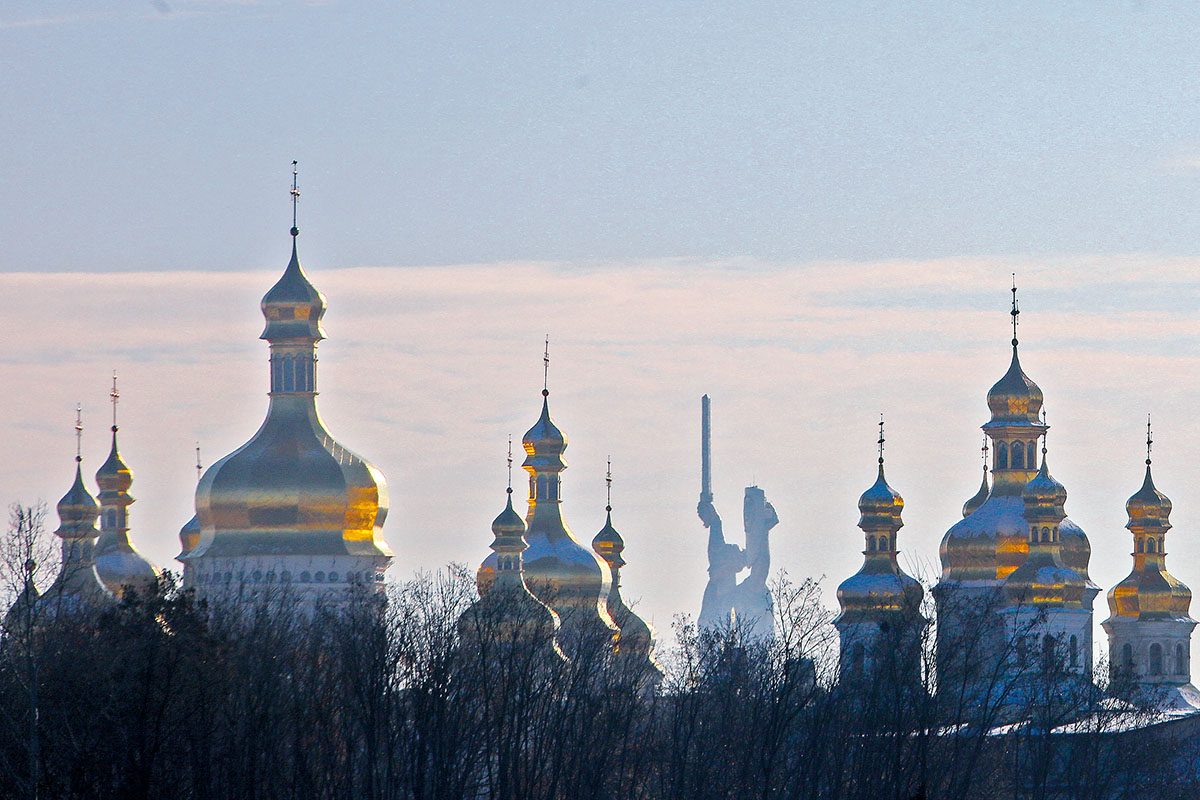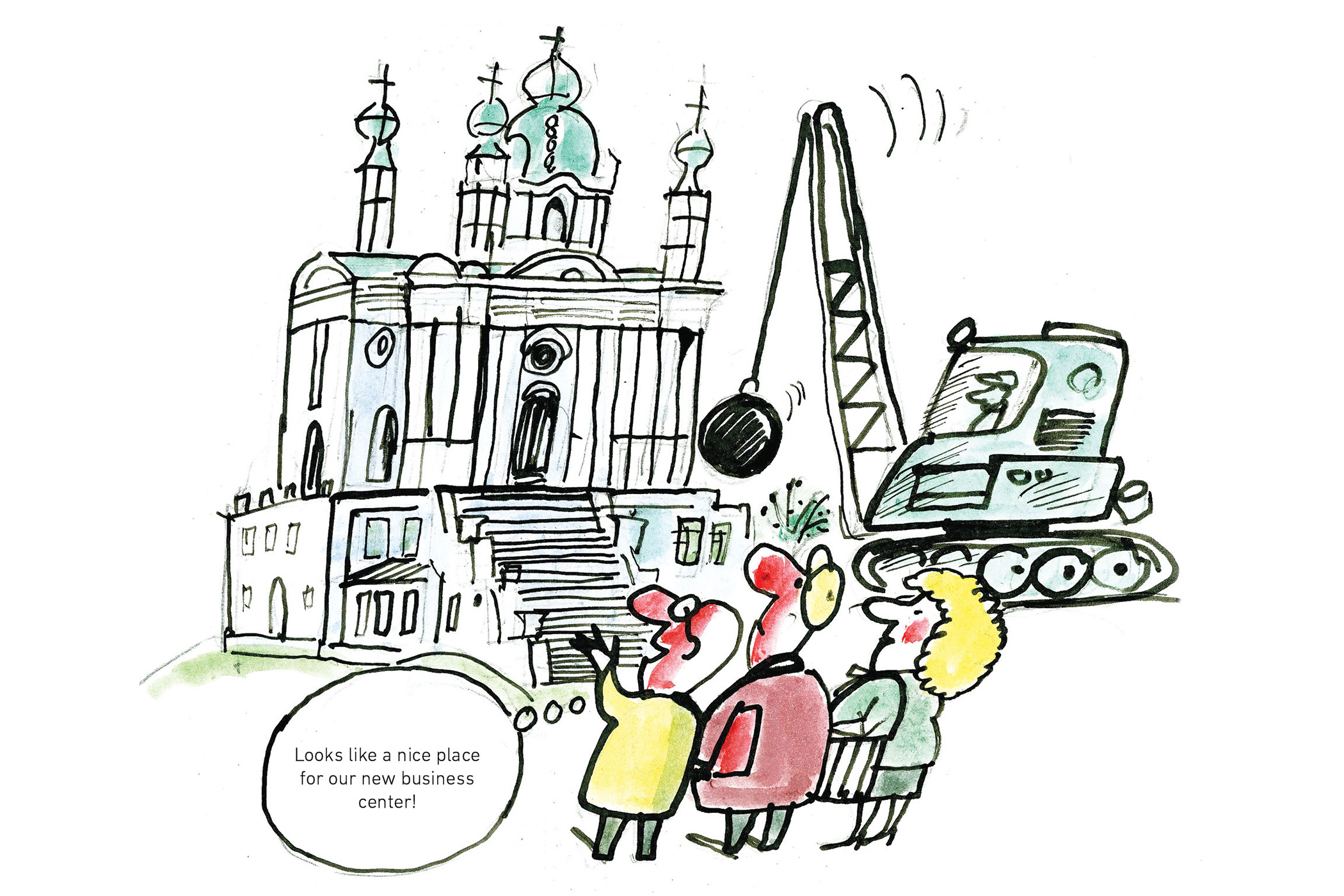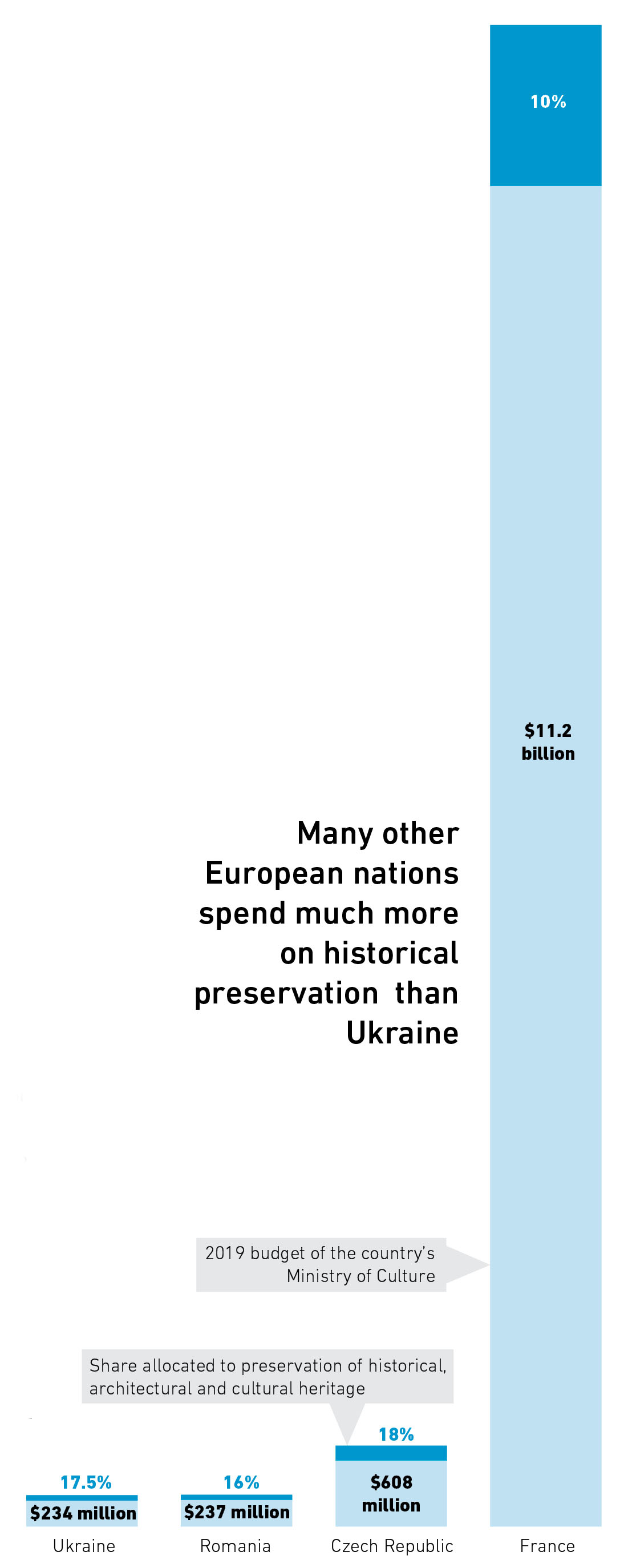Editor’s Note: Our 2019 Doing Business in Ukraine magazine is out. Get a PDF version online or pick up a copy in Kyiv.
Kyiv’s historical and architectural heritage is at risk of disappearing and, with it, the authenticity of the city.
Allocations of insufficient funds, a centralized, opaque system and a dysfunctional legal framework illustrate how far the country is from its European neighbors. Ukraine is endangering at best — and losing at worst — landmark architecture throughout the Ukrainian capital as well as around the country. It will take serious introspection and bold reforms in order to put the country on the safeguarding track.
Low budget
When it comes to state policies, budgets often reflect lawmakers’ ambitions. As it happens, Ukraine allocates considerably less funds to its Ministry of Culture than European countries — even those that have less incentives to invest money for preservation.
The Ukrainian state has allocated Hr 6.9 billion ($234 million) to the Ministry of Culture for the 2019 fiscal year. Out of that, only Hr 1.2 billion ($41 million) were allocated to the preservation of historical and architectural projects. In comparison, France has allocated slightly above one billion euros for 2019 to the preservation of its historical heritage out of the 10 billion euros given to the Ministry of Culture. The Czech Republic — a country with a population of 10.6 million people — has allocated 13.5 billion korunas ($608 million) to the Ministry of Culture for 2019.
One could argue that countries like France or the Czech Republic have greater incentive to provide more funding for preserving their historic architecture. In 2017, for example, France alone attracted 87 million visitors whereas Czech Republic had 21 million.
But even when looking at neighboring Romania, the country’s Ministry of Culture allocated one billion euros in 2018 — five times more than in Ukraine for 2019 — whereas the number of foreign tourists in Romania in 2018 reached only 2.8 million, compared to 14.2 million in Ukraine.

The Eastern Orthodox monastery Kyiv-Pechersk Lavra is prey to several pedestrian bridge projects that would likely alter the UNESCO world heritage site. (Volodymyr Petrov)
Municipal vs state power
Apart from the funding, Ukraine does not have a strong system that would protect Ukraine’s historical heritage.
Kateryna Gonchareva, a journalist who specializes in historical and architectural heritage preservation in Ukraine, told the Kyiv Post how the centralized nature of the decision-making process inherited from Soviet Union does not even give local authorities a say in constructions that alter the historical parts of their own cities.
“Anything that happens in historical centers of any Ukrainian city is being dealt with by the Ministry of Culture… just like in Soviet times, every decision is made at the center” said Gonchareva.
France has a more decentralized system, similar to the rest of the European Union, where the responsibility of signing-off construction permits lies primarily upon local authorities.
Historic preservation expert Olga Rutkovska, a member of Ukraine’s National Committee of International Council of Monuments and Sites (ICOMOS), agrees with Gonchareva. In Ukraine, the Ministry of Culture is solely responsible for making decisions regarding historical heritage, which is opposite to European nations where the responsibility is shared between national and local authorities, and where members of society also have a say.
In Paris or Prague, both local and national authorities have to work together.
According to Rutkovska, construction projects altering historical buildings outside of Ukraine’s capital are being signed-off in Kyiv without consulting local authorities, and sometimes without the local mayor being notified.
For locals to complain, they must travel to the capital where decisions are made, causing more obstacles to oppose a construction permit for anyone not residing in Kyiv, according to Gonchareva.

Opaque system
In Paris, construction permits are published online for everyone to see, whereas in Kyiv, the lack of effective transparency is problematic.
Karine Mourot, a representative from Paris Historique, an association that advocates for the safeguard of Parisian historical architecture, says that the problem in Paris is that there are not enough people available to check all permits. But in Kyiv, there is no such list that is easily publicly available.
A list of permits is said to exist in Ukraine somewhere on the Ministry of Culture’s website portal, but the system’s poor design makes it difficult and dissuasive to access, according to Vitaly Beletskiy, a member of the General Council of the Organization for the Protection of Ukrainian Historical and Cultural Monuments.
The Kyiv Post compared the accessibility of the list of construction permits for Paris and Kyiv. A simple google search is enough to illustrate the gap between the two cities.
Whereas the research for Kyiv results in a page full of links to various real estate companies, the one for Paris leads directly to the city’s website, on which one may find a live map of the city.
The map even differentiates between the constructions projects that have been submitted, approved or refused, with a detailed description for each.
Ownership vs. preservation
Frequently in Ukraine, private owners buy historical buildings to let them decay and fall apart as they are not allowed to destroy them by law. Once the building is destroyed, the empty land plot often becomes a new sight of a commercial project like a business center or a mall.
So even though owners are not allowed to demolish the historical buildings, they are not obligated to preserve them. As a result, buildings often deteriorate to a point of no-return and destruction becomes inevitable — if only for safety measures.
Is this issue only in Ukraine? No, it is not.
France and the Czech Republic encounter the same problem, according to expert and head of the Club for the Old Prague, Richard Biegel. Even though the demolition of buildings that are categorized as historical monuments is forbidden, nothing compels owners to invest their money into restoration. Biegel confessed that “Prague’s architecture is heavily influenced by money,” too.
Moreover, in Ukraine “the public registry of property rights isn’t synchronized with the list of historic buildings,” Rutkovska said during an interview with the Kyiv Post 2018. This makes the tracking of construction projects even more difficult.
Legal framework
Laws pertaining to the preservation of historical heritage do exist in Ukraine, but there is no authoritative body that holds to account those who violate them, according to Beletskiy.
This illustrates a major discrepancy in regard to European countries where if a construction permit is refused, it is impossible to circumvent the decision made by authorities — to the risk of facing serious judicial pursuits.
In Czech Republic for instance, Monika Rutland, a Czech lawyer who specializes in urbanization in Prague, told the Kyiv Post that a construction that has been realized without the consent of the city, in the historical center of Prague, could be destroyed or required to be returned to its original state if alterations of a historical building were made — all at the violator’s expense.
When a construction involves a building labeled as historical in Czech Republic, there needs to be an approval by the Commission of Monuments in addition to the local district’s approval, which is very difficult to obtain, according to Rutland.
“It is like a permit within a permit,” she said.

The Ukrainian Ministry of Culture’s budget mirrors that of its counterpart in Romania – a country that is less than half of Ukraine’s size and has 23 million fewer people. Despite that, Ukraine spends only slightly more on historical preservation.
Historical sites in peril
Kyiv’s iconic landscape represented by the multiple hills that surround the Dnipro river are currently endangered by reckless constructions that threaten to modify the city’s scenery.
In Prague, such reckless constructions would be difficult to build considering the whole process one must go through before launching a major project.
The Czech law imposes three pre-construction phases. First, one needs to envisage its project in accordance to what is called “the city’s master plan,” as Rutland explained. The city is essentially divided in residential, commercial and industrial zones.
“It is extremely difficult to change the masterplan,” Rutland said.
“If you buy land in the wrong zone, it can take years to change… if you buy land in the right zone, then you need a zoning permit… the local construction office will ask for the exact location, the shape, the height and also the (purpose) — how much of it will be commercial or residential.”
For instance, several pedestrian bridges are scheduled to go around Kyiv-Pechersk Lavra, a UNESCO protected sight, within what is considered as its immediate vicinity — or buffer zone — which will unavoidably alter the landmark’s beauty.
This is where Kyiv differs from cities like Prague.
In the Czech capital, “you are not allowed to place air conditioning outside, on the walls or in the yard… it is totally forbidden,” Rutland said.
But, according to Biegel, this is not only a legal issue, it is also an education problem.
In a previous Kyiv Post interview, Beletskiy said: “The problem is that not only (business people) don’t see the value of historic architecture, neither do regular citizens.”
